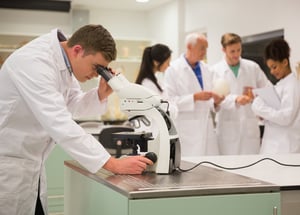Fume hoods play an essential role in any laboratory, keeping technicians safe from toxic chemicals by providing a ventilation system.
The primary function of a laboratory fume hood is to exhaust any type of substance that may cause harm, such as fumes, aerosol, gasses, vapors and dust. They also create a barrier between the lab when a chemical reaction occurs.
However, for a fume hood to provide this important measure of protection, it’s important for technicians and lab workers to use it both effectively and correctly. Here are some tips to ensure your laboratory fume hood adequately protects against toxic fumes, chemical spills and dangerous reactions.
Minimize Air Disturbances
 Airflow disturbances can reduce a fume hood’s effectiveness. That’s why finding a suitable site for one is essential to maintaining good working order.
Airflow disturbances can reduce a fume hood’s effectiveness. That’s why finding a suitable site for one is essential to maintaining good working order.
When having a fume hood installed, place it where crosscurrents can be avoided. Many things can create a crosscurrent, including:
-
Pedestrian traffic
-
The opening and closing of doors
-
Windows
-
Supply air diffusers
-
Exterior fans
Though avoiding high-traffic areas is important to ensure maximum containment, so is how a lab worker moves around the hood. Avoid quick motions in or out of the hood that may create an air disturbance.
Ensure Exhaust Is Working
Before beginning work, lab technicians should always ensure the exhaust is working. Exhausting fumes is the main job of a hood, so if this part of the ventilation system isn’t working, the hood will not operate effectively.
When ensuring the exhaust is working, check the baffles. These are movable partitions that create openings in the back of the hood. They keep airflow uniform, which increases efficiency. Check for any obstructions that may impede airflow.
Also, if the hood includes an airflow monitor, regularly check the monitor’s status. Ensuring that it is properly functioning will allow you to better examine any suspected changes in airflow.
Practice Good Procedures
 Even in equipment that features an exceptional fume hood design, high efficiency is only possible if the equipment is used effectively. Following proper operating procedures is key.
Even in equipment that features an exceptional fume hood design, high efficiency is only possible if the equipment is used effectively. Following proper operating procedures is key.
Each type of fume hood will come with its own set of manufacturer’s instructions and procedures. However, examples of good laboratory fume hood procedures typically include the following:
-
When there is a large apparatus on the inside of the hood, put blocks under the equipment so that air can flow beneath it.
-
Always keep the hood closed except when setting up the apparatus or when working in the hood.
-
Keep any containers or equipment six inches or more from the face of the hood.
-
To maximize performance, keep the hood sash closed whenever possible. If a power outage occurs, lower the hood sash to within an inch. This creates a chimney effect that allows some air to continue flowing into the hood.
-
Be extra careful with certain materials, such as paper products, chemical wipes and aluminum foil. Lightweight materials such as these can easily get sucked into the exhaust, impeding airflow.
-
If using a bench top fume hood, utilize the sliding sash barrier. It’s there for protection and allows you to keep your face on the outside of the work area.
Prioritize Housekeeping and Maintenance
Incorporating proper housekeeping and updated maintenance procedures are essential to ensuring your laboratory fume hood is operating effectively and at high performance. Some housekeeping and maintenance procedures that should be implemented include:
-
Don’t store items, including chemicals, in the hood. Not only can they block airflow, they can interfere with containment as well. Vanderbilt University Medical Center recommends keeping at least 50 percent of your work surface clear at all times.
-
Store hazardous chemicals in approved safety cabinets. If chemicals are needed for a procedure, only keep the smallest amounts in the hood. Biosafety cabinets serve a different function and are specifically designed to offer protection against biological material exposure. It’s important to use the correct cabinet for the particular chemical or biological material.
-
If you operate a ductless fume hood, be sure to check your fume hood filters to make sure they are clean or need replaced. When clean, carbon filters play an important role in removing hazardous fumes and particles from the lab.
-
Evaluate the hood before usage not only for blocked airflow, but excessive turbulence as well.
-
Have fume hoods certified, at least every year, to ensure safe operation. Typical tests may include velocity measurements and smoke tests. Certifiers also will perform tracer gas containment tests. These types of tests are especially important since face velocity not always accurately predicts a leakage in the fume hood.
-
Clean up spills immediately. If a splash occurs, ensure that the glass on the fume hood glass is wiped clean.
Summary
If your hood is not operating properly, contact the manufacturer immediately so your fume hood can be tested. Proper maintenance is key to ensuring your laboratory fume hood continues to work effectively and keeps technicians who are onsite safe from hazardous reactions and toxic fumes.
Considering getting a fume hood for your laboratory? Learn more about the differences of each type and how they are effectively used in a lab by reading our article, Ducted Fume Hoods vs. Ductless Fume Hoods.


